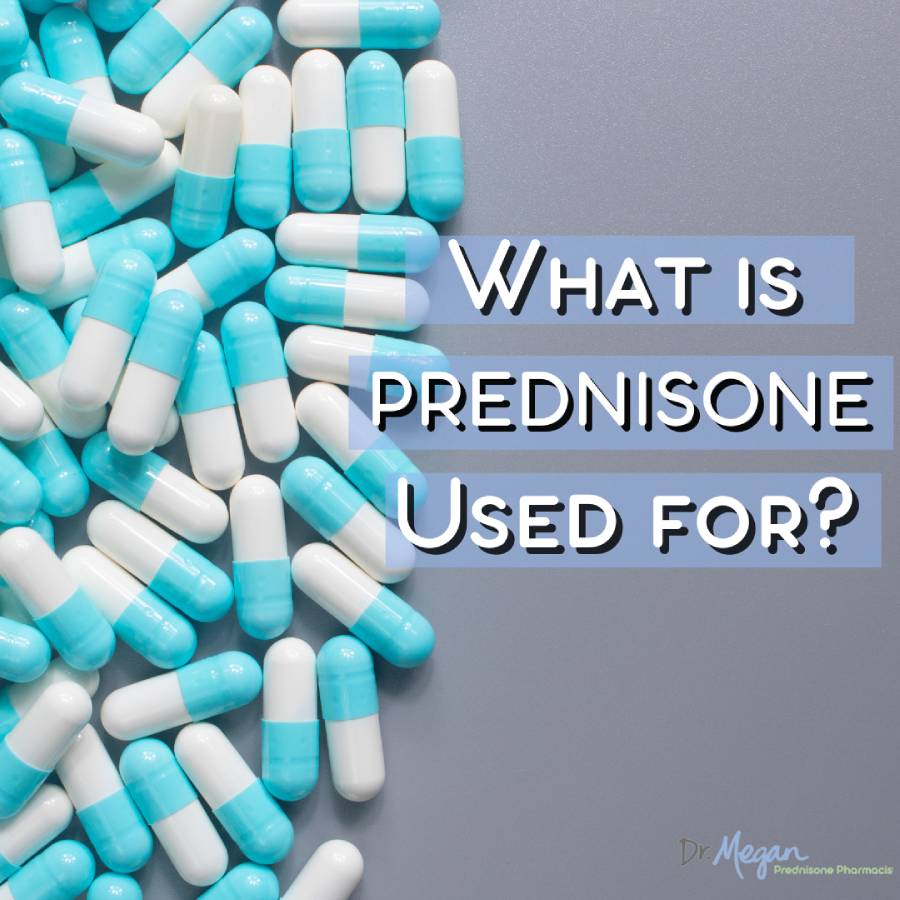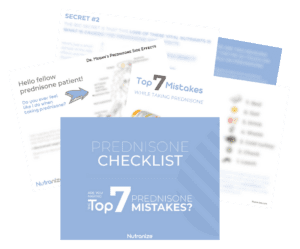What is Prednisone Used For? The Ultimate List

Taking prednisone is not like a gun sniper with a narrow target. Instead, it is like shooting with a shotgun: its side effects scatter throughout the body and are potentially devastating. However, because it affects every part of your body, it actually helps in many ways. Prednisone isn’t just used for one disease. It is used for many diseases, diagnoses, and conditions. See the complete list of reasons people use prednisone at the end of this article.
Risks vs. Benefits
While prednisone causes many side effects throughout the body, in return, it helps many various conditions. On the contrary, however, Prednisone has a slim risk-benefit ratio, meaning that it has many risks, so the benefits must outweigh the risks to justify its use.
For many patients, this is certainly a miracle drug, saving their lives and helping them feel well. Unfortunately, that miracle comes at a price: the miserable side effects.

A Commonly Prescribed Drug
As the 22nd most commonly prescribed drug, prednisone is often prescribed for a long list of conditions, as shown below. Although it has numerous side effects, this medicine can be lifesaving and miraculously relieving for conditions such as pneumonia, organ transplants, asthma, chronic obstructive pulmonary disease (COPD), lupus (systemic lupus erythematosus or SLE), rheumatoid arthritis (RA), psoriatic arthritis (PsA), and ITP (immune thrombocytopenic purpura) –which is what I have.
In the medical literature, roughly 100 different conditions are listed on the package insert of ways in which prednisone can be use. In addition to this, there are another fifty in well-respected drug references. Therefore, it is easy to say that prednisone is an all-around problem-solving drug.
Two Sides of Prednisone Coin

The list of conditions for which prednisone is used is the opposite side of the coin of the side effects it causes. Basically, if you look at a list of potential side effects of any typical prescription drug, prednisone causes most of the possible side effects, and the ones it does not create, it actually treats that condition.
- Many prescription medicines cause a side effect of headache; prednisone is the opposite and can be used to treat severe migraine.

- While some medications may cause breathing difficulties as a side effect; prednisone can help asthma, COPD and many other respiratory conditions.
- Some medications cause kidney injury, but prednisone helps with kidney issues like nephritis.
Prednisone affects nearly every part of the body and can either help or hurt each part. Sometimes, it can both help and hurt at the same time. For example, prednisone can help migraines, but also some people can have a headache when going through prednisone withdrawal. The unique mechanism of action of prednisone causes this unpredictable effect.
The image below shows which side effects Dr. Megan experienced:
Dr. Megan’s Side Effects

Prednisone is an Old Drug
Since the Food and Drug Administration (FDA) approved prednisone in 1955, prednisone did not have to undergo as many rigorous tests as new drugs. Although newer drugs are tested for safety and efficacy, prednisone was not given such rigorous tests; it was grandfathered in and bypassed many tests. The FDA label, also known as the package-insert, shows 91 different diseases or conditions for which prednisone is “approved,” (as shown by no asterisk mark next to the disease name). This chart, below, shows 109 different diseases or conditions for which prednisone is prescribed by doctors, but there are more than likely many more. All diseases with an asterisk mark are used “off-label,” or in other words, without research done before 1955 or accepted by the FDA.
A Few Interesting Facts
- 91 conditions FDA-approved for prednisone
- 18 conditions “off-label” for prednisone use
- 109 total diseases listed in medical literature
Since prednisone is so old, there is no single drug company holding the patent. Because of this, there is no company or agency actively seeking for a complete and comprehensive list of all reasons prednisone is used.
No complete list of prednisone uses exists!
Let’s create a complete list and fill in this gap of prednisone facts.
- Check to see if your condition is listed in the chart below.
- If not, and you think your condition should be added, let me know on the contact page.
What Is Prednisone Used For?
| Type of Condition | Prednisone Indication |
| Allergic States | Control of severe or incapacitating allergic conditions intractable to adequate trials of conventional treatment in drug hypersensitivity reactions |
| Drug hypersensitivity reactions | |
| Seasonal or perennial allergic rhinitis | |
| Serum sickness | |
| Dermatologic (Skin) Disorders | Atopic dermatitis (eczema) |
| Bullous dermatitis herpetiformis | |
| Contact dermatitis | |
| Erythema nodosum leprosum* | |
| Exfoliative dermatitis/erythroderma | |
| Leprosy reaction* | |
| Mycosis fungoides | |
| Pain management in herpes zoster* | |
| Pemphigus | |
| Severe erythema multiforme (Stevens-Johnson syndrome) | |
| Severe psoriasis | |
| Severe seborrheic dermatitis | |
| Endocrine Disorders | Congenital adrenal hyperplasia |
| Hypercalcemia of malignancy (cancer) | |
| Nonsuppurative thyroiditis | |
| Primary or secondary adrenocortical (adrenal) insufficiency | |
| Thyroiditis, subacute* | |
| Thyrotoxicosis (type 2 amiodarone-induced) * | |
| Gastrointestinal (GI) Diseases | Crohn’s disease |
| Ulcerative colitis | |
| Hematologic (Blood) Disorders | Acquired (autoimmune) hemolytic anemia |
| Congenital (erythroid) hypoplastic anemia/Diamond-Blackfan anemia | |
| Erythroblastopenia (red blood cell anemia) | |
| Immune thrombocytopenia (formerly known as idiopathic thrombocytopenic purpura) in adults | |
| Pure red cell aplasia | |
| Secondary thrombocytopenia in adults | |
| Miscellaneous | Alcoholic hepatitis* |
| Autoimmune hepatitis* | |
| Bell palsy* | |
| Duchenne muscular dystrophy* | |
| Giant cell arteritis (temporal arteritis)* | |
| Glucocorticoid remediable aldosteronism, treatment* | |
| Infantile hemangioma* | |
| Pericarditis* | |
| Takayasu arteritis* | |
| Trichinosis with neurologic or myocardial involvement | |
| Tuberculous meningitis | |
| Neoplastic (Cancer) Diseases | Acute leukemia of childhood |
| Multiple myeloma (previously untreated; transplant-ineligible) * | |
| Palliative management of leukemias and lymphomas in adults | |
| Prostate cancer (metastatic)* | |
| Treatment of acute leukemia and aggressive lymphomas | |
| Nervous System | Cerebral edema associated with primary or metastatic brain tumor, craniotomy, or head injury |
| Multiple sclerosis exacerbation | |
| Ophthalmic (Eye) Diseases | Allergic conjunctivitis |
| Allergic corneal marginal ulcers | |
| Anterior segment inflammation | |
| Chorioretinitis | |
| Choroiditis | |
| Diffuse posterior uveitis | |
| Graves orbitopathy* | |
| Herpes zoster ophthalmicus | |
| Iridocyclitis | |
| Iritis | |
| Keratitis | |
| Ocular inflammatory conditions unresponsive to topical steroids | |
| Optic neuritis | |
| Severe acute and chronic allergic and inflammatory processes involving the eye and its adnexa | |
| Sympathetic ophthalmia | |
| Uveitis | |
| Renal (Kidney) Diseases | Proteinuria in lupus erythematosus |
| Proteinuria in the nephrotic syndrome | |
| Respiratory (Lung) Disease | Allergic bronchopulmonary aspergillosis |
| Aspiration pneumonitis | |
| Asthma | |
| Berylliosis | |
| Chronic obstructive pulmonary disease (COPD) exacerbation | |
| Fulminating or disseminated pulmonary tuberculosis when used concurrently with appropriate antituberculous chemotherapy | |
| Hypersensitivity pneumonitis | |
| Idiopathic bronchiolitis obliterans with organizing pneumonia | |
| Idiopathic eosinophilic pneumonias | |
| Idiopathic pulmonary fibrosis | |
| Loeffler’s syndrome not manageable by other means | |
| Pneumocystis carinii pneumonia (PCP) associated with hypoxemia occurring in an HIV-positive individual who is also under treatment with appropriate anti-PCP antibiotics | |
| Symptomatic sarcoidosis | |
| Rheumatic Disorders | Acute and subacute bursitis |
| Acute gouty (gout) arthritis | |
| Acute nonspecific tenosynovitis | |
| Acute rheumatic carditis | |
| Ankylosing spondylitis | |
| Epicondylitis | |
| Polymyalgia rheumatica* | |
| Post-traumatic osteoarthritis | |
| Psoriatic arthritis | |
| Relapsing polychondritis | |
| Rheumatoid arthritis (RA), including juvenile rheumatoid arthritis | |
| Sjögren syndrome | |
| Synovitis of osteoarthritis | |
| Systemic dermatomyositis (polymyositis) | |
| Systemic lupus erythematosus | |
| Vasculitis |
“*” = Disease that is not listed on the FDA-approved label or package insert but listed in well-respected medical references, such as:
Was your condition listed in this chart? If not, please contact Dr. Megan and we can add it to the list! Below are other Prednisone Warriors said they use prednisone for.
Conditions Suggested by Prednisone Warriors that Prednisone is Used For:
- Polymyalgia Rheumatica (PMR)
- Dermatomyositis
- Myasthenia Gravis
- Scleroderma
- Chronic urticaria (hives)
- Hidradenitis suppurativa
- Granulomatosis with Polyangiitis (Wegener’s disease, GPA)
- Eosinophilic granulomatosis with polyangiitis (Churg-Strauss Syndrome, EGPA)
- Labyrinthitis
- Covid-19
- Pyoderma gangrenosum
- Hemifacial atrophy
- Addison’s disease
- NK Cell deficiency disorder
- Poison oak
- Severe L5-S1 nerve pain
- Spinal stenosis and osteoarthritis
- Bell’s Palsy
Video Explanation of What is Prednisone Used For?
Watch now!
For Which Conditions is Prednisone Used Long-term?
Check out this article and video I created to explain which conditions use prednisone long-term.
Cautions to Take with Prednisone
When taking prednisone, the lowest effective dose should be prescribed. While the dosage may start off higher, the goal should be to get the dose as low as will keep your condition stable. NEVER stop taking this medication without talking to your doctor, as there are severe withdrawal effects. Your body stops creating certain hormones (cortisol) when you take prednisone. Therefore, in order to give your body time to kick in the hormone-making factory, the adrenal gland, you must slowly stop taking it over weeks to months’ time.
NEVER stop taking prednisone suddenly.
Is Prednisone Worth It?
In conclusion, if you are wondering whether taking prednisone for your condition is really worth it, check out this article that walks you through the decision. I created it to help explain the risks and benefits. In this article, you will find out how to ensure the benefits are greater than the risks.
Related Posts
-
75+ Scientific Articles and Nutranize Zone Ingredients
Based on scientific evidence Every ingredient in Nutranize® Zone supports prednisone nutrient repletion.* Zone counterbalances the effects... -
9+ Supplements to Avoid While on Prednisone
In this article, we will discuss 9+ supplements to avoid while taking prednisone and the... -
10 Nutrients You Need While on Prednisone
Prednisone is a medication commonly prescribed to treat inflammatory conditions such as arthritis, asthma, and...


